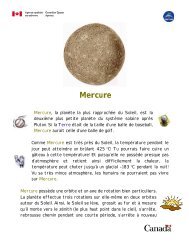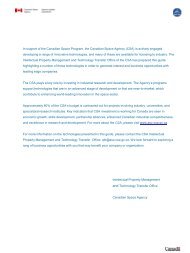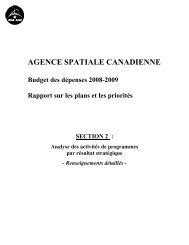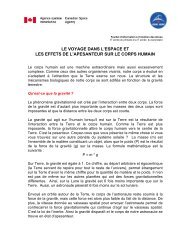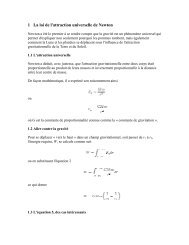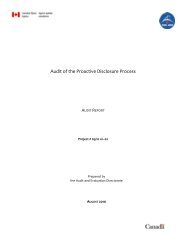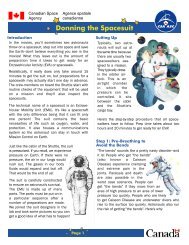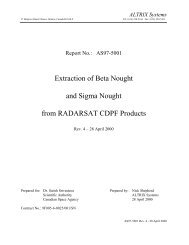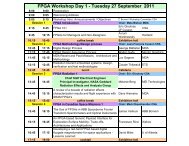PDF version of COSPAR - Space Science Research in Canada Report
PDF version of COSPAR - Space Science Research in Canada Report
PDF version of COSPAR - Space Science Research in Canada Report
You also want an ePaper? Increase the reach of your titles
YUMPU automatically turns print PDFs into web optimized ePapers that Google loves.
In addition, the scientists use what Llewellyn describes as a tomography-liketechnique to process images obta<strong>in</strong>ed by detect<strong>in</strong>g the absorption <strong>of</strong> sunlightpass<strong>in</strong>g through the atmosphere. These types <strong>of</strong> images are used to measurestratospheric ozone and nitrogen dioxide.The amount <strong>of</strong> data process<strong>in</strong>g required is stagger<strong>in</strong>g. At first, Llewellyn, whocame up with the idea along with a colleague, Ian McDade, thought there wassimply no practical way to do it. “We realized that no matter how fast computerswere, it was go<strong>in</strong>g to be a very slow process; we would never keep up with therate at which the data came <strong>in</strong>.”However, never one to say never, Llewellyn set Degenste<strong>in</strong>, then a graduatestudent, to the task. With the approval <strong>of</strong> the Canadian <strong>Space</strong> Agency, whichwas fund<strong>in</strong>g the research, Degenste<strong>in</strong> spent two years work<strong>in</strong>g with the Ottawacompany, Routes AstroEng<strong>in</strong>eer<strong>in</strong>g, that was build<strong>in</strong>g the <strong>in</strong>strument. Dur<strong>in</strong>g thattime, he developed a system that can process 100 m<strong>in</strong>utes <strong>of</strong> data <strong>in</strong> fivem<strong>in</strong>utes—20 times faster than “real time.”“He did make it sit up and beg,” said Llewellyn proudly. “We were overjoyed, butwe still hadn’t flown at that stage.” Several people told him that it was “awonderful idea but it can never work.” Even when they got their first flight resultsand presented them at an <strong>in</strong>ternational conference, the skepticism persisted.Llewellyn said: “People looked at it and said, ‘Yeah, f<strong>in</strong>e; we don’t believe you.’ ”It took a few years for them to conv<strong>in</strong>ce the skeptics but “now it’s the acceptedway <strong>of</strong> look<strong>in</strong>g for structures <strong>in</strong> the atmosphere. Everybody knows what theyhave to do next.”In the meantime, the science team has been expand<strong>in</strong>g the range <strong>of</strong> atmosphericcomponents that OSIRIS is look<strong>in</strong>g at. Melo noted that the <strong>in</strong>strument unique <strong>in</strong>its ability to measure water vapour at altitudes <strong>of</strong> about 80 to 90 kilometres. Thisis <strong>in</strong> the upper mesosphere, one <strong>of</strong> the highest regions <strong>of</strong> the atmosphere.The water content <strong>of</strong> the atmosphere is a key component <strong>in</strong> cloud formation andOSIRIS is currently study<strong>in</strong>g an <strong>in</strong>trigu<strong>in</strong>g phenomenon called polar mesosphericclouds, the highest clouds <strong>in</strong> the atmosphere. Some scientists believe they’reoccurr<strong>in</strong>g more frequently and could be “a true canary <strong>in</strong> the coal m<strong>in</strong>e for globalchange,” Llewellyn said.However, Melo noted that “the processes that lead to the formation <strong>of</strong> theseclouds are not fully understood and that’s where OSIRIS is contribut<strong>in</strong>g.” Shesaid that measur<strong>in</strong>g polar mesospheric clouds started out as a secondary61



